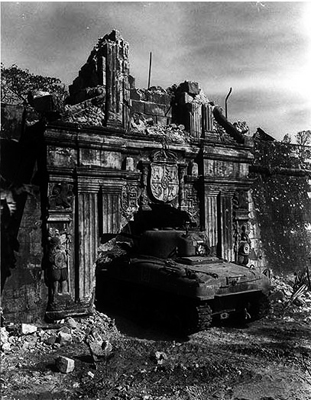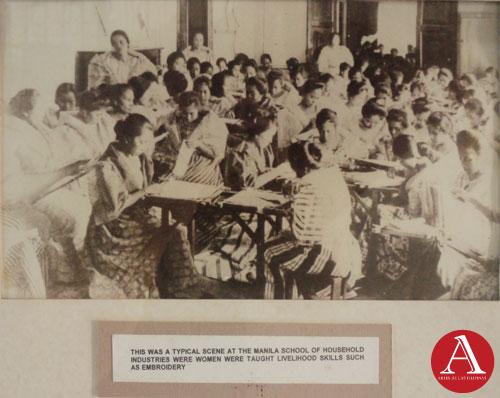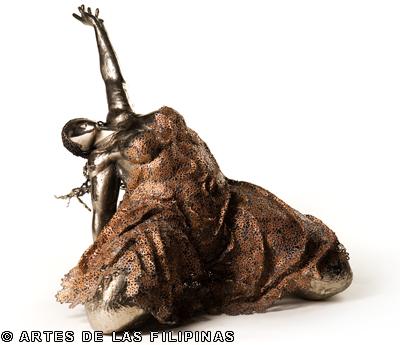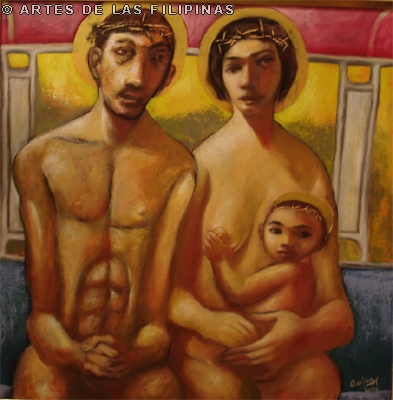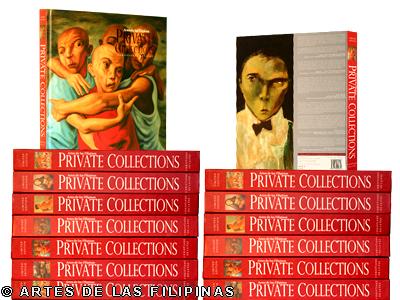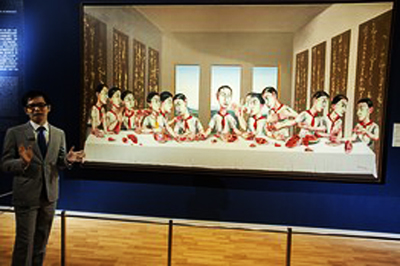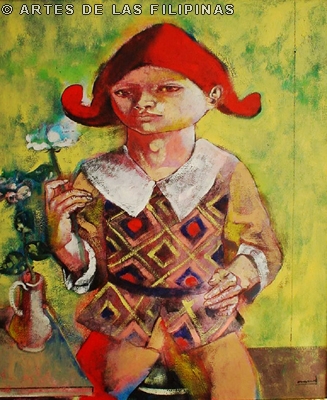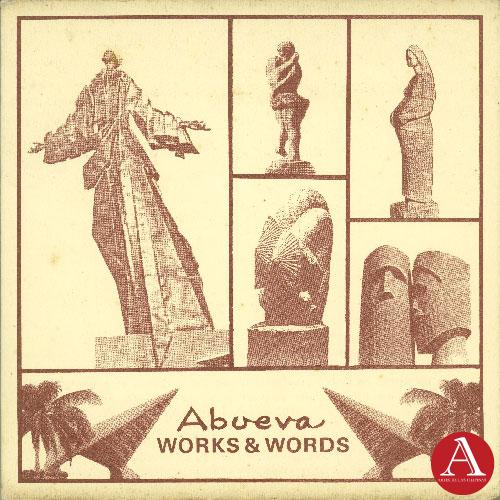
Abueva Works & Words
By: N. Veloso Abueva
Concept of Design
Whatever desire
is expressed in Form,
one conceives
in the realm of Design
the mind in
the hand can falter
or surpass!
If you answer which one
how much was done by love?
Executed into sculpture in bronze.
Collection of Mrs. I.R Marcos
(originally written for the 3rd one-man design show, Architectural Center, Makati, 1960)
On Being A SCULPTURE
A sculpture is like a price fighter and a matador all rolled into one. As a boxer, he has to be on the top condition, mentally and physically. The latter demands a sustaining courage and grace to remain in the arena.
When I was very young, the materials of sculpture were so yielding and responsive. Now that I am older, I have come to terms with the stubbornness and coldness of these materials. They are making me aware of the years that I have gained.
I work on functional objects on the basis of sculptural problems, rather than on utilitarian objective, as diversion from pure sculpture. —
–1969
CONTEMPORARY SCUPLTURE IN THE PHILIPPINES
BEFORE THE LAST PACIFIC WAR, practitioners in sculpture were primarily on the traditional methods such as modelling in clay and direct carving in wood. A great majority of the modeled clay would normally undergo the molding and casting process and become a plaster or concrete cast and a few would eventually cast in bronze in Italy.
Among the sculptors who did the clay to cast method were Professor Guillermo Tolentino, Francisco Monti, Anastacio Caedo, and a few others. All of them work in a classical or conservative manner with the exception of Francisco Monti whose works were stylished and more conventional.
In direct carving in molave wood, Sculptor Graciano Nepomuceno stood almost alone. His depiction of familiar themes in high relief and religious pieces were exquisitely carved. In direct carving in marble or stone it was rather rare except for the number of pieces executed by Tolentino and those religious piecesdone by a tallieres or studious of Maximo Vicente and Oriol. Practically all marble used in statuary came from Italy. The churches and cemeteries were the usual consumers of these statues and hardly any of them would find its way into the private houses. Romblon marbles was never used seriously as a sculptural material except in recent times.
Some years after liberation, Ramon Estela did some direct carving in adobe. The few pieces he carved possessed the quality of some primitive stone sculptures in the Indian Aztec. The immediate years following saw the application and the experimentations of new methods, techniques and materials in which the emerging generations of sculptors preoccupied themselves. Their concept in art, their outlook in life was no longer identical with their former mentors but in most cases they were at variance. Consequently, the redefinition and re-evaluation of what is considered “ a thing of beauty” in sculpture and in art in general underwent a drastic and dynamic transformation. This change in concept was attuned to the changing sensibilities of the times.
Form in itself assumed a new plastic dimension and significance. Contemporary sculptors became mainly obsessed in creating forms which they considered significant. The literal meaning of the forms they made were nowhere to be found and they deemed it unnecessary in most cases. Gone were the usual sweet depiction of the beautiful or lyrical countryside, which were the favorite concern of the older group of sculptures and painters.
And in the process, as the contemporary sculptors became so immersed in their pursuit to produce forms per se, the further they became alienated in presenting themes which were typical or native, least to those who subscribe to the old and fading sensibility. Pure form and good design became the paramount objective. Unconsciously, their works did not bore the character nor can it be equated to a particular body of works.
With the rising nationalism in the fifties and sixties, the question or issue was discussed and talk about. To some perhaps in their desire to attempt to contribute to the issue at hand, some artist tried to depict Philippines motifs in their works. Unfortunately, nothing significant resulted in their attempt, for they realize later that it was a superficial imposition on their part and not voluntary and natural impulse to do that particular body of works.
It must be taken into account that for so long the orientation of the most of our artist has been in western thought or school. To expect them to produce suddenly a body of work which would reverberate the national idiom or identity, to the satisfaction and whims of our outspoken nationalist, is not impossible but utterly deplorable. “Art is long and element of time cannot be disregarded.
National identity in art is desirable but not necessary. The immediate and foremost duty of the Filipino artist is to produce good art, as it is the duty of any artist elsewhere in the temporal world. The elements of arts are universal and impersonal in nature and these elements give essence and validity to the so called international style or school. As a sculptor, I have always believe that whatever desire is expressed in form, one conceives entirely in the realm of design and no other consideration should be seriously taken into account.
These days our sculptors are engaged in practically all contemporary techniques in sculpturing. They do not only cast their works in reinforced concrete but also in bronze using either the sand or the loose wax method. Among the sculptors who cast their works in their improvised but efficient studio foundries are Francisco Cruz, Jose Mendoza, Abdul Mari Imao, Leonides Valdes, and Napoleon Abueva .
Those who normally do direct welding in acetylene or electric welding are Gewrry and Virginia Navarro, Eduardo Castrilo, Solomon Saprid and Abdul Mari Imao.
Those who work on combination of welding, constructing and metal rising are Lamberto Hechanova, Raul Isidro, Mercado, Beltran, and others. Materials such as sheet metal in brass, copper, aluminum, lead, and plastics are now commonly used. Some are already experimenting in resin and glass.
The practitioners of the traditional methods of molding and direct carving but in contemporary style or manner are Jose P. Alcantara and his son, Boy Caedo, Froilan T. MAdrinan, Jr., Victor Tabernilla, Rene Rocha, Ross Arcilla, IIdelfonso Marcelo, Romulo de Jesus, Anselmo Dayag, Eugenio Bunuan, Jose Flores, and others. Roberto Chabet and Ray Albano’s group are engaged in environmental sculpture and some related experiments which possess some degree of sophistication.
Arturo Luz works on wood and metal with plastic architectonic forms. Danilo Dalena works on Plastic and comes out with striking sense of plasticity. While it appears in this paper that there are quite a number of sculptors, the facts remains that there are really a handful of full time practicing sculptors. It is rather a paradoxical that with so much to be done in private homes and commercial edifices, there are so few sculptors who are really actively working. Likewise, in schools, there are hardly any students majoring in sculpture. Why? What does it really take to be a practicing contemporary sculptor?
The truth of the, matter is that aside from manual labor involved in practically all its aspects, a sculptor has to be a carpenter, mason, welder, plumber and at times electricin and above all a sort of weight lifter. On top of this, the highly expensive tools and materials in sculpture make sculptureing prohibitive, especially to young sculptors. With all these requirements, it certainly does not encourage students to be sculptors’ inspite of the need and increasing opportunities.
Much as I would like to see more art students take up sculpturing, I do not, as a personal policy, freely encourage them to be prospective sculptors, being so mindful of the demands of the profession. Only those who have made up their minds and have been fully exposed to the various types of work involed are to be encouraged and given all possible assistance. –1970

THE FULBRIGHT PROGRAM’S CONTRIBUTION TO PHILIPPINE DEVELOPMENT IN THE VISUAL ARTS
EARLY THIS YEAR, when Dr. Ruby K. Mangahas, is a very active director of the Philippine-Fulbright Scholars Association, informed me of my participation in the 30th anniversary of the Fulbright Program in the Philippines, I was originally assigned to speak or report on the visual arts, being a participant in the field.
The assignment could not have been too difficult since all these years I have been struggling in my chosen field of livelihood. The many and now distinguished beneficiaries of the program have been my contemporaries, especially the younger ones. Furthermore, we are all familiar with their works and the respective contributions to the arts. However, when one has to speak of the contribution of the arts to Philippine Development, that is a complete different story and frankly, I feel like a stranger in my assigned field. For some time, the assignment seemed insurmountable, engulfing my mind and heart. Later, it reminded me an experience twenty four years ago when I had to fill up the Fulbright application form in which one had to stat one’s objective, what one intended to do upon one’s return and so on and so forth. I must have sounded like a missionary then, like other applicants. This time I’m afraid, I might sound again like a missionary. But perhaps with the difference with that, to some extent and with the sense of satisfaction, I have done some of the items I stated in my application form.
My problem now or dilemma has been compounded by my own suggestion to Dr. Mangahas that architecture, interior design or industrial design, photography and theatre design be so represented, since the program includes these fields, with some outstanding grantees.
To minimize my problem I thought of a way of helping myself out. In covering the field of interior design, I gladly sought the assistance of our good friend, and a pretty good person and practitioner, Ms. Edith L. Oliveros (FSM ‘60). So, an informative and good page has been added to my short.
Similarly, in Architecture, I did not hesitate to solicit the assistance of architect Leandro V. Locsin (Specialist ’59). Mr. Locsin’s statements and also those of Mr. Nicholas Polites on the architecture of Mr. Locsin have also been incorporated in the paper. With said addition and some quotations from other sources, I think that my modest participation in this evening affair will be fair enough. If not, please add a few more points from the small exhibit at the lobby plus your power of positive thinking.
We live in the age of great challenges, excitement and adventures with man trying to respond as well to the human and physical problems of his time. As part of this response, we have witnessed the marriage of art and industry, art and technology, art and and science. Some may say the union illicit or lecit but the fact remains that it is a contemporary reality. In the Philippines, It is no longer surprising to find artist actively involved in theatre and industrial or trade design, in photography and film, advertising and typography, science and industry, whether in government or private business. In Brief, artists have become more and more involved in the day to day life of their community.
“Speaking of how Philippine architecture relates to society, Leandro V. Locsin once observed:” The architecture of my country is a syntheses of our society. Our art of building reflects our people at a specific time, their aspirations, traditions, culture, economic resources, technology, environment, climate, and all the other components of Philippine society. This relationship between architecture and society is universal, for it exists in other cultures beside ours. Yet the relationship has another dimension, in as much as an architect’s work is the expression of one individual, the person who puts himself into the particular problem that a structure addresses, whether it is a house, a building or any structure designed for particular function. In this sense, it is the architect’s subjective view of a specific challenge to which he responds with a personal solution and personal statement.”
Mr. Nicholas Polites, who wrote the introduction of the book,: The Architecture of Leandro V. Locsin,” in turn has observed (about the art of Locsin) and I quote:” He (Locsin) is by far the leading architect in his country. Already he has put an indelible stamp on Philippine architecture through his work spans only a little twenty years…
“The most ambitious attempt to merge art and architecture is seen in the Cultural Center’s Theater of Performing Arts, commissioned by the new First Lady, Mrs. Imelda Romualdez Marcos in 1966. Giving a free hand In the design of the building its interiors and its embellishment, Locsin deliberately reserved carefully selected wall areas with the work of specific artist in mind, such as the Manansala brass sculpture in the orchestra foyer, the Castrillo stainless steel sculpture, and the spectacular murals by Legaspi and Luz in the small theater. Instead of the usual brocade or velvet curtains, he had tapestry woven after a painting of Ocampo for the large theater, defining the color range of both to contrast and to relate with the interior surfaces. The resulting theater, remarkable structure, is now an internationally recognized Manila landmark.”
Mr. Polites further observes:
“The idea of architecture plays an important role in many of Locsins’s later building s, The lobby of the Theater of Performing Arts, for instances is another hollowed out sculpture, – here stairways rise out of the floor in the flowing lines or seem to uncurl in symmetrical rings when seen from below. The monumental clocks of the International Convention Center are meticulously formed to lighten the massing and their arrangement is pure and simple sculpture on a gigantic scale. The interiors are extensively sculpted the grand sweeping stairways, which appear to emerge organically from the floor: the molded concrete balconies mezzanines their profiles softened and contoured to contrast with severe linear elements. But the idea of sculptural interior is by no means arbitrary,” “I have already thought that what happened inside a building should release to the outside”, says Locsin. The sculpted quality of the lobby merely continues the sculptural concept of the exterior.
All the new buildings for culture and the arts spring from the common root, however different they are in outward appearance and function. They were planned to foster national pride in the Philippine heritage. The arts, in the Marcos administration’s view, are profoundly involved with the spiritual welfare, the soul of the nation. Both the creative arts and the performing arts are therefore actively encourage by government policy to help developed in the Filipinos a sense of national consciousness too long dormant under centuries of foreign domination.
“The edifices commissioned for social, civic and scientific projects with which the First Lady is equally concerned also reveal the unmistakable feature of Locsin’s synthesis of what is Filipino. The Population Center of the Philippines, the Nutrition Center, the Asian Center of Training and Research for Social Welfare and Development, and other related edifices are characterized by vernacular building features.”
Finally, Mr. Polites observes: On every level, Locsin is profoundly involved with Philippine, culture and this could be termed as Philippine architect.”
In the field of Interior Design, we have a very active and leading practitioner who has been and still as the Director of the Cancio School of Interior Design, Fullbright-Smith_mundt grantee’ 60 from Drexel University.
Miss Oliveros has this to say: “The past twenty years have been an active period in interior design in the Philippines considering the development of building both residential and commercial structures that has taken place in all areas of the country. With the development of architecture come the awareness of the interior design, hence the rapid pace of the profession and the allied trades.
“Today, we have an active profession ranging from the purely professional interior design to the more informal decorators, drapery makers, and furniture manufacturers, artist and artisan, to the interested general public who has become aware and cognizant of the contribution of the interior design in our quality of life.
“The contribution does not only lie in the creation of beautiful rooms but also in the development of functional interiors, most especially at the time when life for many in the urban areas have become more complex. We have introduced into our lives a necessity for mechanical equipment’s such as air conditioning, sound systems, noise control, special lighting systems, and more efficient storage and spaces for physical, intellectual and spiritual development. The need for just basic shelter no longer holds true and today in the Philippines homes we find the answer to the need for a home, for an environment that services our lifestyles be it simple apartment or a bigger residence for an executive a building for a businessman or a mansion for the affluent.
“It is an exciting time for interior design in the country for the development is now reaching the greater number of the populace. Coupled with the inherent interest of the Filipino for beautiful things, more allied traders such as woodworking, furniture making carpet and wallpaper manufacturing are developing their products. It is also the time for the development of a lot of native materials that can be used for homes and the average Filipino has finally accepted that what is local is good and can be used beautifully.
“One can go leisurely into our commercial buildings our shopping centers, small housing villages, small stores and apartments, big hotels, beauty parlors, our major cities and smallest towns and one cannot but see the influence of an interior designer. The directions at least are there.”
The degree of community involvement, activity and interest among the local artistic community during the past ten years was also made possible by other Fulbrighters in the field of architecture, photography, painting and sculpture. Among them is Architect Honorato Paloma who is presently involved in town planning, ecology and education, is also the architect in charge of the U.P. complex in Miagao, Iloilo and soon to raise U.P. Film Center in Diliman, Architect Jaime Nierras who is in government construction projects; architect Angel E. Nakpil and Jesus Bondoc who are both actively engaged in private practice; theater designer Salvador Bernal who is presently very active in stage presentation in the country; photographer Evaristo Nievera who branched out into film documentary; painter Constancio Bernardo who is very active both as artist and educator ; sculptor Abdulmari Lmao, who is currently immersed in scholarly research and dissemination of indigenous and traditional Muslim art and design the adobe sculptures of Ildefonso Marcelo grace the grounds at the U.P. in Quezon City. Painter Rodolfo Paras Perez, the first Filipino artist to get doctorate in art history at Harvard, is now actively engaged in the print media aside from his art, research and teaching; paiter Arturo Luz who currently heads the MOPA, the Metropolitan Museum of Manila and the Design Center of the Philippines which provides the guidance to local trade and industry for their graphic need and requirements; painter Jose Joya who has done murals to the private and public buildings and theater productions design is also in ceramics; painter Federico Alcuaz who is also a ceramics and now sculptor, has done a lot of tapestry for private and public buildings and will do the tapestry murals for the new Olympic sports palace in Moscow; and recently Ray Albano, curator of the CCP who undertook a unique art experience in disseminating Philippine visual activity in states grantee who has for many years now been in furniture design and also in amusement parks for children as well as sculpture for public and private use.
With the increased tempo of artistic and creative activity in the various fields of human activity, public appreciation and recognition for accomplishments of our artist have also increased. There are more art collector’s art galleries and art dealers now.
One cannot help but mention the valuable contribution of the first lady, Mrs. Imelda Romualdez Marcos. To mention only one of the many art in society.” This has limited the inventiveness of most artists to purely stylistic experiments or the indulgence in fantasy or the depiction of the grim humor or nostalgic recreation of past eras.
The question of “whom art should serve” becomes the most pressing question for the artist who seeks to makes the artist of “whom art should serve” becomes a most pressing question for the artist who seeks to make his art meaningful and responsible not only to himself but also to his people. (On this score, I must admit that I am one of those wanting in this particular aspect though conscious of this shortcoming). He must realize, for the sake of his art and his people, “That although art is universal, its universality is particularized by geographical, racial, social and historical condition and development of individual societies. Indeed, it is through the artist’s creativity that the individuality and peculiarities of man and the human condition in the artist race, moment and milieu are transmuted into art and the specific and the particular are crystalized and elevated to the ideal and universal.”
In our nation’s Constitution, it is stated that the promotion and enhancement of art and culture must be the prime concern of the state. However, if the implementation of this constitutional provision, it is to suit the vested interest of few, then the state might as well disregarded this provision.
We should not be merely preoccupied with our bare existence with rice and fish to the exclusion and at the expense of the appreciation of the finer things in life that lend beauty and meaning to our lives. –1975

THE STATE OF THE VISUAL ARTS
Much has been said and written about the state of the visual arts at present, the very active and successful artists and the ever-widening base of art clientele or patrons in the Metro Manila area and a few isolated cities outside Metro Manila.
These artists, consciously or unwittingly, serve the interest, predisposition or inclinations of their patrons. Just as it has been observed, that art or culture of a given period in history serves the interest of a select or prevailing minority. This apparent allegiance to the controlling class is its comfortable and uncritical submission to the prevailing order of things education varies in the degree of importance and emphasis according to the deeds of the individual whether he intends to be practicing artist, an art appreciator or merely desirous to be enlightened in the multiple aspect of art education.
Art schools and colleges at most could only provide an impart the rudiment techniques and skills imperative in the visual arts.
The curriculum which provides general education courses in the first two years out of a four year curriculum is practically standard feature of most arts schools. An indeed two shorts year of subjects in the humanities is sadly wanting and so glaringly inadequate. At most it is a sprinklings or what you may describe in Filipino as “padapyas dapyas lng.” Why is it so or why it has to be this way is a question of element of time. There are indeed a number of subjects to contend with the field of specialization in visual arts, such as sculpture, painting, and visual communication and in art education proper.
Thus it is to the advantage of students who supplement this inadequacy by exposing themselves to the various offerings presented in the other arts throughout the academic year, namely the performing arts and the theater arts. This is where a student in the university or big institution has the added advantage if they avail themselves of the many undertakings presented by the other art disciplines.
The constant exposure, association and broadening of the artist to other related arts is of paramount importance. However, the fact is that most graduates in the fine arts are wholly preoccupied in their field of specialization and hardly knowledgeable of the fundamentals in the other fields of tradition seven arts.
In last Saturday’s discussion, the barcada system or grouping of artists was mentioned by Mrs. Pura Kalaw Ledesma. While it has some good points in its association and fellowship and in achieving desirable goals, in most cases it does provide little room for advancement in broadening their respective perspective from within. Just like the saying, that birds of the same feathers flocks together. And unless a bright and new bird develops or is introduced in the flock, there would hardly be a change in their direction and improvement.
At this juncture it might be of interest to ask a hypothetical question regarding the possible effects on the part of our late National Artist Botong Francisco, had he been able to travel. It is common knowledge that for so many years Mr. Alejandro Roces, before and he was a Secretary of Education, several times tried and secured scholarship for Francisco to travel and observe art trends and centers abroad. However, Botong Francisco always came up with the same problem. Or excuse that he was not in a position to leave until death overtook him. Of course, it is debatable whether an exposure, say to Mexican art in general and mural painting in particular would have a positive or negative effect in his art. Certainly, this does not imply that he could have been greater as a result of more exposure and broadening of his pictorial and intellectual horizon.
Our contemporary artists by and large have been successful in producing quality works of art. In Asia, it is safe to say we are ahead compared to other countries in the region as far as depiction or interpretation in the contemporary idioms. Nevertheless, no matter how good the composition, color,” the swirl of impasto,” and form, there is the question of intellectual content, the elusive quality of element which tends to elude even some of the best of our works. This question of depth always persists in the evaluation of major art works.
At this point, I am afraid I am going to lose some of my friends for being critical and frank. However I must tell you, I am not an exception to this charge or indictment if you may consider it as such. Perhaps at this very instance, an art critic ought to be saying this thing. He would be less vulnerable than a practicing artist. But we have to admit the fact that if we would be doing a disservice to the real development and promotion of our art. Indeed it is difficult to pinpoint or zero in such element because of its unapparent nature but somehow seemingly apparent of its absence when confronted with a given work of art.
There are no ready explanations on this matter. At most, we can only cite and deduce from the training or education of a particular great master of the past and of all times.
In the world of Giorgio Vasari, a contemporary and a friend of Michaelangelo, “but he who bears the palm of all, whether the living or the dead, he who transcends every other, is the diving Michaelangelo Bounarote, who takes the first place, not in one of this arts only, but in all three (obviously this refers to sculpture, painting, and architecture). This master surpasses and excels not only all those artist who have well high surpasses nature but even all the most masters of antiquity who did, beyond all doubt vanquished her most gloriously, he alone has triumphed over the latter, as over the earlier, and even nature herself.”
It must be recalled that when Michaelangelo was summoned to the court of Lorenzo de Medici, at a very young age, ‘he was virtually in the community of scholars. For in those years, the Medici court was composed of the most famous poets, philosophers and artist of the time.
One can deduce further the fact that in later year that the most favorable environment in intellectual pursuit, he must have imbibed and benefited from his exposure and association with the profound thinkers of the time.
The innate genius that he was must have been fortified from these rare and most favorable if circumstances. The range of Michaelangelo’s subjects is too vast to contemplate in which a mere plastic and pictorial training and experience would be insufficient.
The conceptual diversity and scale of his immense works must have been gleaned from and influenced by the thinkers and the scholars in the Medici Palace. Truly, his case is a classic example of the importance of the humanities in the life and work of an artist.
In the early decades of the century, the great French sculpture Auguste Rodin, was always in close association with the leading thinkers and writers of his time and the great artist in their fields especially the dance.
Likewise, in more recent times Norway’s Gustav Vigeland, the sculptor responsible for the famous sculpture in Oslo has among his associates men in Literature and Art Criticism.
In speaking of the advantages and profound aspects that humanities play in shaping and remolding the intellect of an artist, I cannot help but cite the unique case of our own, Hernando R. Ocampo. A writer in Filipino and in English, he was once an editor, art critic, producer of radio plays and a member of progressive movement. Simply, Mr. Ocampo has been an active participant in the mainstream of literary and visual activities for so long. Mr. Ocampo, positively, has sizable advantage over, most of us and he is one of our foremost artists in the Philippines today.
Paradoxically, as far as the records of leading art schools in the country are concerned, H. R. Ocampo does not exist.

UP Gateway. 1967. Reinforced Concrete Diliman, Q.C.
Associate Designer: Architect Jess Reyes
Builder: UP Physical Plant

Consummate Embrace. 1970. Bronze. Artist’s Collection

Caganapan. 1957. Marble. Artist’s Collection

Bagong Buhay. 1974. Marble. Artist’s Collection

Baby Moses Floating. Sculpture. 1951. Wood. Cranbrook Academy of Art, Michigan, USA

Family Group. 1952. Wood. National Museum of the Philippines

The Rice Planters. 1952. Wood. Purita Kalaw-Ledesma Collection, Makati

(Water Buffalo). 1968. Marble. City Art Museum, St. Louis, Missouri, USA

Play Sculpture. 1968. Reinforced Concrete. Artist’s Collection

Divider and Reception Desk. 1967. Wood and Metal. Meralco Building, Manila

Door J. Moreno Residence. 1966. Bronze and Wood

Sculptured Bench. 1977. Wood. Artist’s Collection

Woman’s World. 1971. Marble. Private Collection. USA

Born Free. 1967. Wood and Iron. Camp Aguinaldo

Water Catapult (For the Burning of Books of Alexandria). 1990. Wood, Broze and Copper. Artist’s Collection

Homage to D.M. Consunji. 1973. Reinforced Concrete. Cainta, Rizal

President Carlos P. Garcia Statue. 1962. Bronze. Tagbilaran, Bohol

Ceremonial Urn at Dambana ng Cagitingan. 1968. Reinforced Concrete

Dambana ng Kagitingan Reliefs. 1968. Marble. Architect: Lorenzo del Castillo DMCI-Builder

High Reliefs at Dambana ng Kagitingan Cross. 1968. Reinforced Concrete. Mt. Samat, Bataan

Structure. 1969. Wood and Iron. UN Building, New York, USA

Tribute to the Filipino Entrepreneur. 1970. UP Institute of Small Scale Industries, Diliman, Quezon City

Ilohan (Presser). 1970. Wood. Stone and Bronze. Development Arts of the Philippines, Tagaytay, City

Allegorical Harpoon. 1964. Wood. XXXII Venice Biennial. Cultural Center of the Philippines

Kiss of Judas. 1955. Wood. Detroit, Michigan, USA

Crucifix. 1957. Wood. U.P.Chapel, Diliman, Quezon City. Leandro Locsion Achitect DMCI Builder

Moses. 1952. Alabaster. Galerie Bleue, Makati

Transfiguration. 1979. Welded Brass. Eternal Gardens Memorial Park. Caloocan City
CITATION
Napoleon Veloso Abueba, hardly in his middle age, is the acknowledge patriarch of modern sculpture in the Philippines.
Restless, daring, imaginative he blazed new paths in his chosen art. A protean innovator in a craft which demand high skill, he is the weather vane of contemporary sculpture, planting the seeds of future growth in creation whose full implication, in terms of form and their limits in terms of material, remain the object of continued exploration by his peers and apostles.
Napoleon Veloso Abueba is the born expirementor . Seeking to extend the boundaries of his art he invented “buoyant sculpture” which has intrigued puzzled and finally inspired his generation of sculptors. He has also created play sculpture and sculpture furniture, both of which reflect his originality and versatility.
But it is for his large monumental works for which he is best known. In the figures of the Christ that he has hewn for chapels and churches all over the country, he reveals an unsuspected religious spirit, large in inception, large still in inspiration. The same spirit informs his secular works as in the historico- heroic murals commemorating the virtues of the race in numerous national shrines.
Napoleon Veloso Abueva is an artist of unquestioned power and seriousness. Massive abstraction of incredible variety and diversity an unfailing inventiveness, a prodigious energy and inexhaustible inspiration firmly imprint his signature in the art of our time. His works are a metaphor for his world and his age.
In these achievements, the country takes his pride.
CITATION OF THE NATIONAL ARTIST AWARDCONFERRES ON NAPOLEON VELOSO ABUEVA BY THE PHILIPPINE GOVERNMENT ON MARCH 27,1976

National Artist Medallion and Collar

The Abuevas. Left to Right. (Seated). Purificacion, Sergia, Socorro (Jose’s wife), Amelia
(Standing) Anthony, Napoleon, Teresita, Teddy and Jose

Bridge of Love. 1970. Reinforced Concrete. Artist’s Collection
PROLOGUE TO THE MOBILE ART AWARDS AND THE SEARCH FOR THE MISSING LINK
It is a fact that most of the paintings are visually beautiful in terms of color, composition, design, subject matter, or even the concept. Most of our paintings are simply a feast for the eyes. But must this kind of picnic (for the eyes) be at the expense or exclusion of the intellectual content or ethical message?
So my immediate reaction upon reading about the 1980 Mobil Awards for Philippine Art was that of admiration and gratefulness to Monsieur Jean Pierre Baileux, Mobil’s president, and the sponsor’s continuing involvement in the advancement of ”the cultural life of the country.”
The establishment of these biennial awards provides a rare and ideal venue to underscore or emphasize the importance of the missing link in our visual arts.
What I mean by the missing link or the plus factor can actually be created if the artist has concern for meaning in depth, or the so called intellectual content.
It is difficult to decipher it sometimes. Yet this quality is always apparent when present in work of art.
Let me cite the examples of Edward Munch and Paul Klee’s paintings, the work of the former possess a sober intellectual content while the latter has witty and sometimes sober was always profound cerebral content. These two artists of course grew up and developed in the western world which is highly intellectual. But is it too much to expect the same qualities two artist have from our own artist. As a people, we are said to be the happy go lucky type. Life in our corner of the globe is not as hard as compared to that in temperature countries. Our sun is always up and our climate is said to be influenced our way of life. Life here is not too serious, so perhaps we can conclude
Easily, too, that most of our artist do not take it life seriously.
But the contention that the geography and climate can determine the nature and sensibility of a people is only valid up to certain extent, otherwise we can safely say that there is really nothing which is missing in our visual arts.
All these years, our artists have been exhibiting abroad with great aims that our art would be understood and appreciated internationally. But sad to say, we have not yet made any kind of dent in the international scene.
Could it be that there is something missing in our art? Yes, it is my firm belief that unless art attains more of the enriching food for the mind, or intellectual content, aside from aesthetic consideration of course, Philippine painting in particular, and Philippine art, in general, will always have this drawback – which I term the missing link in our visual arts.
The advent, of a greater demand and appreciation for painting in the Metro Manila area has compounded the problem and has created a noticeable stress in the production in the production of creative works by a good number of painters. Some painters (the prominent ones) have to calendar and schedule their delivery of artworks. The time required to conceptualize a painting have to give way to the actual production of the painting. As a natural consequence, quantity eclipsed quality. Even the late Hernando Ocampo, one of our most intellectual painters, was an unwitting victim of this syndrome.
Art critic Alejandro Roces, in one of his lectures, described our time by quoting Dicken’s “these are the best of our times; these are the worst of our times.”
The art writer Manuel Duldulao said of the late that our major artists are painting under the shadows of their old works. Leo Benesa, Rod Paras Perez and Emmanuel Torres share the same view and deplore what is happening. I am quite sure that they all want the mind to join the eyes in the festive celebration of Philippine art.
May these 1980 Mobil Awards for Philippine Art reward the painter whose works will fill the missing element that I have been trying to point out. And may the tribe of such kind of painters increase. And may these biennial awards be the best thing ever to happen in Philippine art- at present and in the years to come.
-1981-
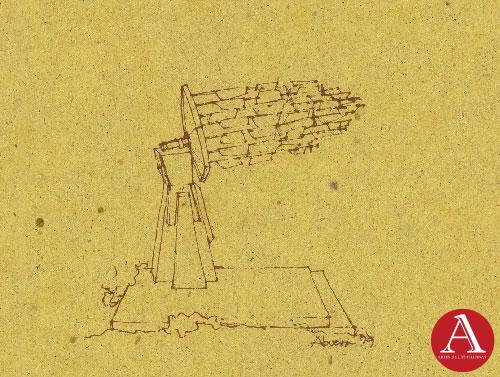
THE SPIRIT OF BUSINESS
When asked by


